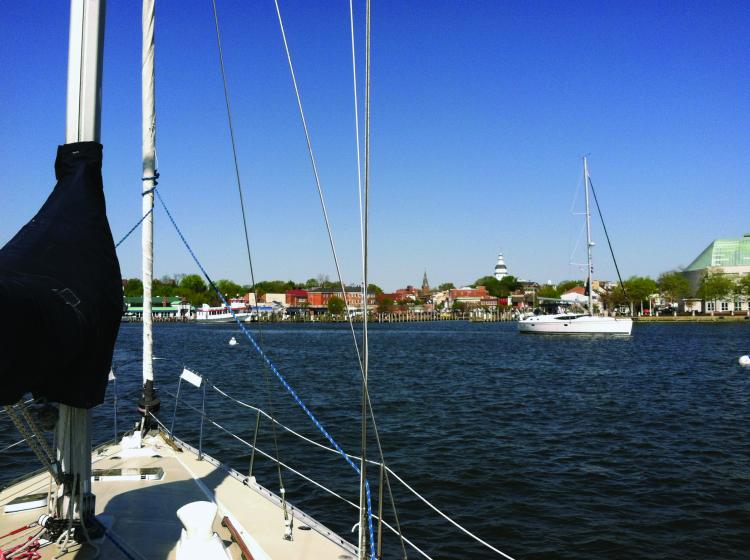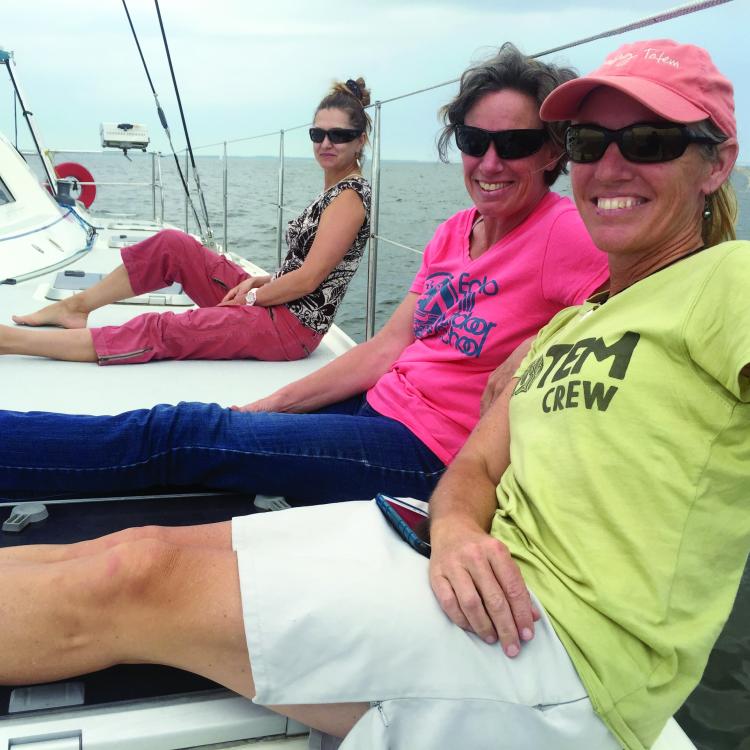What Your Crew Needs To Know Before You Go
It was a beautiful June day in Annapolis, and we were headed out with guests for a day sail on our St. Francis 44 catamaran. Anxious to get out and seize the day, we helped our friend and her toddler aboard, sat them down in the cockpit, and started the engines. My husband and I were scurrying around untying the boat, and our kids were in the cabin, unphased by leaving the dock.
Nobody had an eye on our guest. Her toddler got squirmy as toddlers do. He left her lap, toddled to the helm, and grabbed on to the engine throttles and pulled them full reverse. It’s a good thing we hadn’t finished untying the last two lines, or we would have taken out the whole dock with a mighty crash. The fault was 100 percent ours. As owner and skipper, it’s our job to make sure guests and crew get at least a minimum safety briefing before we head out.
The size of your safety briefing is roughly equivalent to the size of your journey. However, there are some basics that all souls onboard need to know before heading out, whether it’s a Wednesday night race, a weekend trip to Solomons, or an offshore delivery to the islands.
“VHF radio,” says Renee Mehl, director of Offshore Sail Training Squadron at the U.S. Naval Academy. VHF radio was something she mentioned again and again, no matter what kind of sailing you do.
“Teaching basic radio operation, how to hail on channel 16, how to use a working channel, the difference between a Mayday, Pan-Pan, and Sécurité. It’s also good to know that out on the water the VHF will get you help faster than using 9-1-1 on a cell phone,” says Mehl. “For races and cruising locally or offshore sailing, that’s one basic skill to teach your whole crew.”
If for some reason the skipper becomes incapacitated or ends up overboard, at the very least you want the people onboard to know how to get help, and fast. From a basic safety briefing, to weeklong classes, there are many levels of training and learning people can do to become better sailors and better crew.
Spring 2020 would have been the 40th year of the Safety at Sea Seminar, but the pandemic made it impossible last year. For decades the Safety at Sea Seminar at the USNA has been a staple for teaching everything from weather to man overboard drills to hypothermia basics. With a mix of classroom lectures and active, hands on skills training, people flock from all over to attend this weekend seminar in Annapolis.
“It’s now syndicated by US Sailing all over the United States,” says Mehl. “There are also online courses for offshore training at ussailing.org. It’s a good place to learn until the seminars can go back live and in person.”
If crew for offshore voyages can do some learning through US Sailing, or another accredited sail training program, they will have a good base of knowledge on a wide set of skills. It’s not always realistic for your crew to engage in that level of training though. What about grabbing some friends and taking a last-minute weekend trip, or even a last-moment crew grab for a longer trip?
Every boat is different, and there are some basics the owner and/or skipper need to run every crew member through. Besides the VHF radio, take the time to walk your crew through where the PFDs, flares, fire extinguishers, and other safety gear are stowed. Beyond safety gear, your crew should know how to use your propane solenoid, how to properly use your marine head, where to find things such as binoculars, batteries, and chargers. “Sat phone operation is another thing people don’t think about. How to turn it on, and that you need to dial 011 before the number when you call out,” says Mehl.
There are less tangible safety issues, such as the chain of command. “Communication is very important. The skipper is in charge, and that person should designate a second in command in case something happens,” says Mehl.
The crew and guests need to understand that what the skipper says goes, and that’s important for everyone’s safety. If there’s a situation where seconds count, you don’t want someone to get hurt because of a lack of communication.
“Unfortunately, it’s risky and things happen,” Mehl admits. “But we can learn from mistakes, our own mistakes and from others. There have been in-depth studies on things that have gone wrong at sea. We can learn from that, so we don’t make the same mistakes.”
If you have a regular crew for racing or weekend exploring, take a few extra hours on a weekend and head out to do man-overboard drills, heave-to, and reefing. Even a day working on safety drills is a day on the water, so your crew will probably be happy to oblige.
“Get on the boat and do the work. Practice! Then, the crew learns it, and it becomes muscle memory. This is important so that you’re not reinventing the wheel in a bad situation,” says Mehl.
What about the guests who have never been sailing or are very new to it? It may be back to basics, but a safety briefing is still important, even for your dear old Uncle Hal and Aunt Sally. Make sure they know the boom has a reputation with that name, make sure they know how to navigate around the boat when it’s heeling, be mindful of open hatches on deck, and one hand for you, one for the boat.
No matter what kind of sailing you do, a good exercise in the off season is to write up a courtesy safety sheet and some standard operating procedures that you can email, text, and physically hand to crew and guests when sailing season starts. Think of it as the seat-back safety card you always have on an airplane. When your guests and crew come aboard, you can think about the flight attendant doing their five-minute safety talk before taking off. There are lots of safety checklists online that you can use to help you make sure you have everything covered.
“Forewarned is forearmed,” says Mehl. “Emergencies are stressful, but if you know what to do better, you can work through them.”
~By Cindy Wallach






